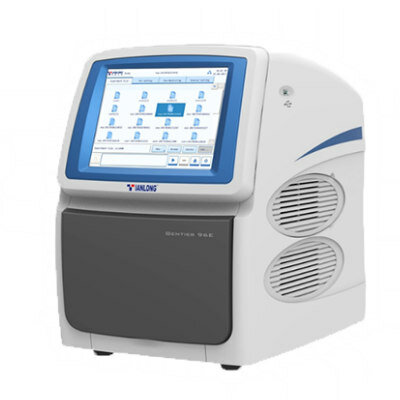Calprotectin Levels Vary When Measured in Different Matrices for COVID-19
|
By LabMedica International staff writers Posted on 28 Dec 2021 |

Image: The Phadia 200 instrument is capable of diagnostic testing menu of more than 700 different ImmunoCAP and EliA tests to aid in the diagnosis of allergy and autoimmune diseases (Photo courtesy of Thermo Fisher Scientific)
Several risk scores, diagnostic imaging and biomarkers have been evaluated and compared to help predict severe complications and outcome in COVID-19 patients. Nevertheless, early prediction of COVID-19 severity remains difficult, emphasizing the need for additional biomarkers in daily practice.
Calprotectin (CLP) is typically expressed and secreted by neutrophils, monocytes, and activated macrophages, but can also be expressed and secreted by other cell lines including but not limited to dendritic cells, endothelial cells, keratinocytes and squamous mucosal epithelium. Circulating CLP (cCLP) has gained recent attention as a biomarker of neutrophil-related inflammation and chronic inflammatory disorders.
Medical Laboratory Scientists at the OLV Hospital (Aalst, Belgium) prospectively included patients with primary diagnosis of SARS-CoV-2, confirmed by real-time reverse transcription polymerase chain reaction (rRT-PCR)) who presented at the emergency department (ED) requiring hospitalization. One hundred and thirty-six SARS-CoV-2 positive patients were included (70 hospitalized at a non-ICU ward; 66 at an ICU ward), next to 40 SARS-CoV-2 negative control patients (20 non-ICU; 20 CV-ICU).
The primary biomarkers of interest concerning the inflammatory response to COVID-19 were cCLP (measured in heparin, EDTA and citrate plasma and serum), C-reactive protein (CRP), Interleukin-6 (IL-6), lactate dehydrogenase (LDH) and procalcitonin (PCT). After routine laboratory analysis, including CRP, LDH and PCT analysis, was performed on blood samples taken at the ED, aliquots of serum, heparin plasma, EDTA plasma and citrate plasma were stored at -20 °C. Batch analyses of cCLP using the EliA Calprotectin 2 assay on a Phadia 200 instrument (Thermo Fisher Scientific, Waltham, MA, USA) and IL-6 (Elecsys IL-6 on cobas c801, Roche Diagnostics, Rotkreuz, Switzerland) were performed on stored aliquots.
The investigators reported that for the 136 COVID-19 patients, cCLP levels were higher compared to the respective control populations, with significantly higher cCLP levels in serum and heparin than in EDTA or citrate. Higher cCLP levels were obtained for COVID-19 patients with i) severe/critical illness (n=70), ii) ICU admission (n=66) and iii) need for mechanical ventilation/extracorporeal membrane oxygenation (ECMO) (n=25), but iv) not in patients who deceased within 30 days (n=41).
The authors concluded that cCLP has a high power to discriminate severe or critical COVID-19 cases versus patients presenting with asymptomatic, mild or moderate disease, to predict the need for ICU admission and the need for mechanical ventilation or ECMO. The study was published on December 14, 2021 in the journal Clinica Chimica Acta.
Related Links:
OLV Hospital
Thermo Fisher Scientific
Roche Diagnostics
Calprotectin (CLP) is typically expressed and secreted by neutrophils, monocytes, and activated macrophages, but can also be expressed and secreted by other cell lines including but not limited to dendritic cells, endothelial cells, keratinocytes and squamous mucosal epithelium. Circulating CLP (cCLP) has gained recent attention as a biomarker of neutrophil-related inflammation and chronic inflammatory disorders.
Medical Laboratory Scientists at the OLV Hospital (Aalst, Belgium) prospectively included patients with primary diagnosis of SARS-CoV-2, confirmed by real-time reverse transcription polymerase chain reaction (rRT-PCR)) who presented at the emergency department (ED) requiring hospitalization. One hundred and thirty-six SARS-CoV-2 positive patients were included (70 hospitalized at a non-ICU ward; 66 at an ICU ward), next to 40 SARS-CoV-2 negative control patients (20 non-ICU; 20 CV-ICU).
The primary biomarkers of interest concerning the inflammatory response to COVID-19 were cCLP (measured in heparin, EDTA and citrate plasma and serum), C-reactive protein (CRP), Interleukin-6 (IL-6), lactate dehydrogenase (LDH) and procalcitonin (PCT). After routine laboratory analysis, including CRP, LDH and PCT analysis, was performed on blood samples taken at the ED, aliquots of serum, heparin plasma, EDTA plasma and citrate plasma were stored at -20 °C. Batch analyses of cCLP using the EliA Calprotectin 2 assay on a Phadia 200 instrument (Thermo Fisher Scientific, Waltham, MA, USA) and IL-6 (Elecsys IL-6 on cobas c801, Roche Diagnostics, Rotkreuz, Switzerland) were performed on stored aliquots.
The investigators reported that for the 136 COVID-19 patients, cCLP levels were higher compared to the respective control populations, with significantly higher cCLP levels in serum and heparin than in EDTA or citrate. Higher cCLP levels were obtained for COVID-19 patients with i) severe/critical illness (n=70), ii) ICU admission (n=66) and iii) need for mechanical ventilation/extracorporeal membrane oxygenation (ECMO) (n=25), but iv) not in patients who deceased within 30 days (n=41).
The authors concluded that cCLP has a high power to discriminate severe or critical COVID-19 cases versus patients presenting with asymptomatic, mild or moderate disease, to predict the need for ICU admission and the need for mechanical ventilation or ECMO. The study was published on December 14, 2021 in the journal Clinica Chimica Acta.
Related Links:
OLV Hospital
Thermo Fisher Scientific
Roche Diagnostics
Latest Clinical Chem. News
- 3D Printed Point-Of-Care Mass Spectrometer Outperforms State-Of-The-Art Models
- POC Biomedical Test Spins Water Droplet Using Sound Waves for Cancer Detection
- Highly Reliable Cell-Based Assay Enables Accurate Diagnosis of Endocrine Diseases
- New Blood Testing Method Detects Potent Opioids in Under Three Minutes
- Wireless Hepatitis B Test Kit Completes Screening and Data Collection in One Step
- Pain-Free, Low-Cost, Sensitive, Radiation-Free Device Detects Breast Cancer in Urine
- Spit Test Detects Breast Cancer in Five Seconds
- Electrochemical Sensors with Next-Generation Coating Advances Precision Diagnostics at POC
- First-Of-Its-Kind Handheld Device Accurately Detects Fentanyl in Urine within Seconds
- New Fluorescent Sensor Array Lights up Alzheimer’s-Related Proteins for Earlier Detection
- Automated Mass Spectrometry-Based Clinical Analyzer Could Transform Lab Testing
- Highly Sensitive pH Sensor to Aid Detection of Cancers and Vector-Borne Viruses
- Non-Invasive Sensor Monitors Changes in Saliva Compositions to Rapidly Diagnose Diabetes
- Breakthrough Immunoassays to Aid in Risk Assessment of Preeclampsia
- Urine Test for Monitoring Changes in Kidney Health Markers Can Predict New-Onset Heart Failure
- AACC Releases Comprehensive Diabetes Testing Guidelines
Channels
Molecular Diagnostics
view channel
Unique Autoantibody Signature to Help Diagnose Multiple Sclerosis Years before Symptom Onset
Autoimmune diseases such as multiple sclerosis (MS) are thought to occur partly due to unusual immune responses to common infections. Early MS symptoms, including dizziness, spasms, and fatigue, often... Read more
Blood Test Could Detect HPV-Associated Cancers 10 Years before Clinical Diagnosis
Human papilloma virus (HPV) is known to cause various cancers, including those of the genitals, anus, mouth, throat, and cervix. HPV-associated oropharyngeal cancer (HPV+OPSCC) is the most common HPV-associated... Read moreHematology
view channel
Next Generation Instrument Screens for Hemoglobin Disorders in Newborns
Hemoglobinopathies, the most widespread inherited conditions globally, affect about 7% of the population as carriers, with 2.7% of newborns being born with these conditions. The spectrum of clinical manifestations... Read more
First 4-in-1 Nucleic Acid Test for Arbovirus Screening to Reduce Risk of Transfusion-Transmitted Infections
Arboviruses represent an emerging global health threat, exacerbated by climate change and increased international travel that is facilitating their spread across new regions. Chikungunya, dengue, West... Read more
POC Finger-Prick Blood Test Determines Risk of Neutropenic Sepsis in Patients Undergoing Chemotherapy
Neutropenia, a decrease in neutrophils (a type of white blood cell crucial for fighting infections), is a frequent side effect of certain cancer treatments. This condition elevates the risk of infections,... Read more
First Affordable and Rapid Test for Beta Thalassemia Demonstrates 99% Diagnostic Accuracy
Hemoglobin disorders rank as some of the most prevalent monogenic diseases globally. Among various hemoglobin disorders, beta thalassemia, a hereditary blood disorder, affects about 1.5% of the world's... Read moreImmunology
view channel
Diagnostic Blood Test for Cellular Rejection after Organ Transplant Could Replace Surgical Biopsies
Transplanted organs constantly face the risk of being rejected by the recipient's immune system which differentiates self from non-self using T cells and B cells. T cells are commonly associated with acute... Read more
AI Tool Precisely Matches Cancer Drugs to Patients Using Information from Each Tumor Cell
Current strategies for matching cancer patients with specific treatments often depend on bulk sequencing of tumor DNA and RNA, which provides an average profile from all cells within a tumor sample.... Read more
Genetic Testing Combined With Personalized Drug Screening On Tumor Samples to Revolutionize Cancer Treatment
Cancer treatment typically adheres to a standard of care—established, statistically validated regimens that are effective for the majority of patients. However, the disease’s inherent variability means... Read moreMicrobiology
view channel
Mouth Bacteria Test Could Predict Colon Cancer Progression
Colon cancer, a relatively common but challenging disease to diagnose, requires confirmation through a colonoscopy or surgery. Recently, there has been a worrying increase in colon cancer rates among younger... Read more.jpg)
Unique Metabolic Signature Could Enable Sepsis Diagnosis within One Hour of Blood Collection
Sepsis is a life-threatening condition triggered by an extreme response of the body to an infection. It requires immediate medical intervention to prevent potential death or lasting damage.... Read morePathology
view channel
Spatial Tissue Analysis Identifies Patterns Associated With Ovarian Cancer Relapse
High-grade serous ovarian carcinoma is the most lethal type of ovarian cancer, and it poses significant detection challenges. Typically, patients initially respond to surgery and chemotherapy, but the... Read more.jpg)
Unique Hand-Warming Technology Supports High-Quality Fingertip Blood Sample Collection
Warming the hand is an effective way to facilitate blood collection from a fingertip, yet off-the-shelf solutions often do not fulfill laboratory requirements. Now, a unique hand-warming technology has... Read moreTechnology
view channel
New Diagnostic System Achieves PCR Testing Accuracy
While PCR tests are the gold standard of accuracy for virology testing, they come with limitations such as complexity, the need for skilled lab operators, and longer result times. They also require complex... Read more
DNA Biosensor Enables Early Diagnosis of Cervical Cancer
Molybdenum disulfide (MoS2), recognized for its potential to form two-dimensional nanosheets like graphene, is a material that's increasingly catching the eye of the scientific community.... Read more
Self-Heating Microfluidic Devices Can Detect Diseases in Tiny Blood or Fluid Samples
Microfluidics, which are miniature devices that control the flow of liquids and facilitate chemical reactions, play a key role in disease detection from small samples of blood or other fluids.... Read more
Breakthrough in Diagnostic Technology Could Make On-The-Spot Testing Widely Accessible
Home testing gained significant importance during the COVID-19 pandemic, yet the availability of rapid tests is limited, and most of them can only drive one liquid across the strip, leading to continued... Read moreIndustry
view channel
ECCMID Congress Name Changes to ESCMID Global
Over the last few years, the European Society of Clinical Microbiology and Infectious Diseases (ESCMID, Basel, Switzerland) has evolved remarkably. The society is now stronger and broader than ever before... Read more
Bosch and Randox Partner to Make Strategic Investment in Vivalytic Analysis Platform
Given the presence of so many diseases, determining whether a patient is presenting the symptoms of a simple cold, the flu, or something as severe as life-threatening meningitis is usually only possible... Read more
Siemens to Close Fast Track Diagnostics Business
Siemens Healthineers (Erlangen, Germany) has announced its intention to close its Fast Track Diagnostics unit, a small collection of polymerase chain reaction (PCR) testing products that is part of the... Read more
















